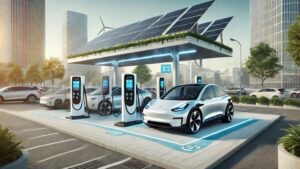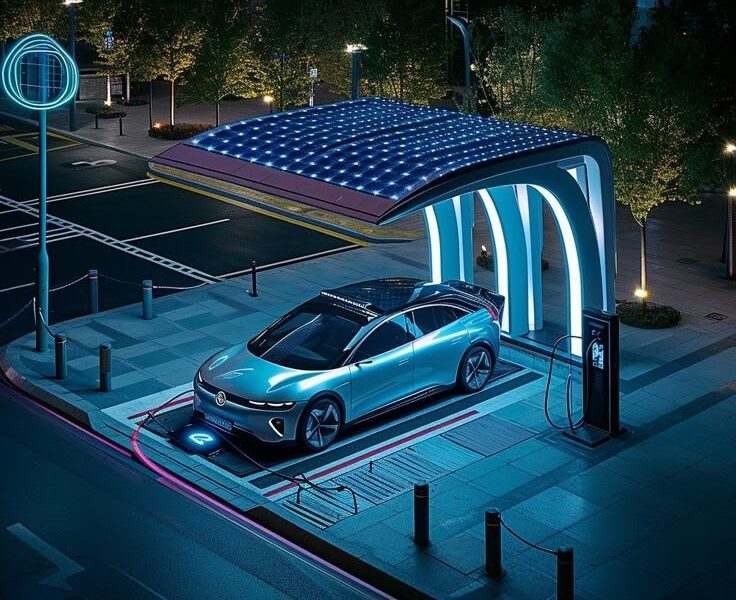**⚡ Revolutionary Race in Battery Technology: New Axis of Global Competition**
The global race for electric vehicles has initiated a revolutionary transformation in battery technology that has reshaped not only the automotive industry but the entire energy sector. Every country and major company is participating in this race to develop the most efficient, long-lasting, safe, and affordable batteries. Research in lithium-ion batteries has achieved extraordinary increases in energy density, significantly improving vehicle range and reducing range anxiety. The development of solid-state batteries has added a revolutionary new link – they are not only safer but also have higher charging capacity than conventional batteries and perform better at high temperatures. China has achieved exceptional expertise in producing lithium iron phosphate (LFP) batteries, which are not only cheaper but also have longer lifespans and are protected from overheating issues. Europe and America are emphasizing battery recycling technologies to recover precious metals from used batteries and reduce their environmental impacts. Emerging economies like Indonesia and Argentina have strengthened their presence in nickel mining, a crucial component for battery production, giving these countries important positions in the global economy. The use of artificial intelligence in battery management systems has improved battery life and performance, enhancing efficiency and longevity. Wireless charging technology has made electric vehicle usage more convenient, freeing consumers from cable hassles during charging. Swappable battery systems have promoted electric vehicle use in areas with limited charging infrastructure, giving consumers battery replacement options. The use of nanotechnology has improved battery electrode performance, increasing charging speed and battery life. Quantum computing has accelerated the discovery of new battery materials, rapidly advancing battery technology. All these developments together are making electric vehicles more accessible to ordinary consumers and continuously driving down their prices.

🌍 **Role of National Strategies: Global Review of Government Policies**
In the global electric vehicle race, various governments have played crucial roles through their national strategies, promoting local industries while strengthening their positions in global markets. China has promoted the electric vehicle industry through subsidies, tax incentives, and infrastructure development, making it the world’s largest electric vehicle market. The European Union has implemented strict carbon emission regulations and increased electric vehicle demand through green recovery packages, rapidly boosting electric vehicle sales in Europe. The United States has announced incentives for electric vehicles under the Inflation Reduction Act to promote local manufacturing. Japan has focused on hydrogen fuel cell vehicles, a unique strategy. India has promoted electric vehicle adoption through the FAME India scheme, aiming to reduce dependence on imported oil. Norway has set world records for the highest electric vehicles per capita, resulting from their eco-friendly policies. South Korea has attempted to become a global leader in battery manufacturing, achieving significant success. Germany has heavily invested in the automotive industry’s green transition, protecting its traditional automotive sector. France has announced a ban on petrol and diesel vehicle sales by 2040, a major commitment. The UK has provided incentives for establishing gigafactories, promoting domestic manufacturing. All these national efforts are driving the rapid expansion of the electric vehicle industry and giving new dimensions to global competition.
🚀 **Innovation Race: Historic Competition Between Traditional and New Companies**
An interesting and historic competition has begun between traditional automotive giants and new tech companies in the electric vehicle industry, generating new inventions and innovations. Tesla introduced the concept of software-defined vehicles, where vehicle functions can be updated remotely. Volkswagen achieved scale through platform strategy, using the same platform for different models. BYD achieved cost efficiency through vertical integration, manufacturing most components themselves. Rivian focused on the electric adventure vehicles niche market, emphasizing off-road capabilities. Lucid Motors strengthened its position in the luxury segment, offering high-quality electric vehicles. NIO focused on battery swapping technology and premium services, providing additional facilities to consumers. Xiaomi highlighted smart connectivity features, offering integration with their electronic devices. Apple started working on autonomous driving technology, preparing for future vehicles. Sony partnered with vision-based sensors, offering advanced driver assistance systems. Hyundai developed hydrogen fuel cell technology, an alternative technology. All these companies are trying to increase their market share through unique strategies and continuously introducing new innovations.
💰 **Affordability War: New Standards in Cost Reduction**
Continuous price reductions in electric vehicles have made them more accessible to ordinary consumers, increasing their global adoption. Battery costs have decreased by 89%, the biggest factor in electric vehicle price reduction. Economies of scale have reduced production costs as production increases. Local manufacturing has reduced import duties, lowering prices in local markets. Simplified designs have reduced assembly costs by decreasing the number of components. Vertical integration has reduced supply chain costs, with companies manufacturing most components themselves. Government incentives have reduced effective prices through tax benefits for buyers. New business models like battery leasing have reduced upfront costs, allowing consumers to lease batteries. The growth of the used EV market has increased affordability, providing opportunities for lower-income consumers. Small and affordable EV models have targeted the entry-level market, suitable for urban use. The expansion of charging infrastructure has reduced total cost of ownership, with charging costs being lower than petrol. All these factors together are making electric vehicles accessible to the middle class and promoting their global adoption.
🔌 **Global Expansion of Charging Infrastructure: New Technologies and Opportunities**
Rapid expansion in charging infrastructure has removed barriers to electric vehicle adoption, with new technologies further developing this sector. Ultra-fast charging stations have reduced charging time, with vehicles charging in minutes. Wireless charging technology has increased convenience, eliminating the need for cables. Vehicle-to-grid technology has helped grid stability, allowing vehicles to sell electricity back to the grid. Solar-powered charging stations have promoted sustainability, using renewable energy. Smart charging solutions have improved load management, regulating charging according to electricity demand. Battery swapping stations have reduced range anxiety, allowing consumers to swap batteries. Highway charging corridors have enabled long-distance travel, deploying charging networks along highways. Home charging solutions have provided daily convenience, allowing overnight charging at home. Workplace charging has promoted commercial adoption, where employees can charge vehicles during work. Public-private partnerships have accelerated infrastructure development, with government and private sector collaborating. All these developments together are making electric vehicle usage more practical and creating conveniences for consumers.
🌱 **New Sustainability Requirements: Comprehensive Environmental Impact Review**
The environmental impacts of electric vehicle production and usage have established new sustainability standards, forcing the industry to become more eco-friendly. Green manufacturing processes have reduced carbon footprint, using renewable energy in factories. Renewable energy integration has reduced operational emissions, using solar and wind energy for charging. Circular economy approaches have reduced waste generation, reusing old components. Ethical sourcing has improved supply chain sustainability, considering workers’ rights when obtaining materials. Water conservation measures have made manufacturing processes more sustainable, reducing water usage. Recycling initiatives have improved end-of-life management, recycling components from old vehicles. Carbon offset programs have achieved net-zero targets, balancing carbon emissions. Use of sustainable materials has reduced environmental impact, using renewable materials. Energy-efficient designs have improved overall sustainability, increasing vehicle energy efficiency. All these measures together are establishing electric vehicles as a more sustainable transportation source and playing a crucial role in environmental protection.
🤖 **Series of Technical Advancements: New Era of Unexpected Inventions**
Competition in the electric vehicle industry has generated several unexpected technical advancements, transforming not only vehicle performance but the entire transportation system. Autonomous driving technology has transformed transportation concepts, with vehicles driving automatically. Vehicle-to-everything (V2X) communication has established new connectivity standards, enabling vehicles to communicate with other vehicles and infrastructure. Augmented reality displays have improved driving experience, showing essential information on windshields. Biometric systems have enhanced vehicle security, with vehicles recognizing users’ biometrics. Smart suspension systems have improved comfort and performance, adjusting according to road conditions. Energy recovery systems have increased efficiency, capturing energy during braking. Thermal management systems have improved extreme weather performance, maintaining battery performance in cold and heat. Lightweight materials have increased range, reducing vehicle weight. Integrated solar panels have provided auxiliary power, capable of charging vehicle batteries. AI-powered predictive maintenance has improved reliability, detecting faults in advance. All these inventions together are preparing electric vehicles for the future of transportation and opening new possibilities.
🌐 **New Challenges in Global Supply Chain: Opportunities and Obstacles**
The global electric vehicle supply chain has created both new challenges and opportunities, forcing countries and companies to adopt new strategies. Demand for rare earth elements has increased, essential for batteries and electric motors. Semiconductor shortage has affected production, crucial for modern vehicles. Geopolitical tensions have raised questions about supply chain resilience, forcing countries to emphasize local manufacturing. Local content requirements have changed manufacturing patterns, with countries preferring local materials. Strategic partnerships have improved supply chain security, with companies collaborating. Diversification efforts have reduced risks, establishing multiple material sources. Digitalization has increased supply chain visibility, enabling real-time tracking. Sustainability standards have promoted ethical sourcing, ensuring workers’ rights and environmental protection. Recycling initiatives have reduced raw material dependency, using old materials in new production. Innovation clusters have strengthened regional ecosystems, establishing R&D centers. All these factors together are shaping the future of the electric vehicle industry and creating new opportunities.
🔋 **Revolution in Materials Science: Series of New Discoveries**
A revolution is occurring in materials science within the electric vehicle industry, where new material discoveries have elevated vehicle performance and sustainability to new heights. Graphene use has improved battery performance, providing better conductivity. Silicon-anode batteries have increased energy density, better than traditional graphite anodes. Solid-state electrolytes have improved safety, less flammable than lithium-ion batteries. Advanced composites have reduced vehicle weight, increasing fuel efficiency. Self-healing materials have increased durability, automatically repairing minor damages. Thermoelectric materials have enabled waste heat recovery, converting engine heat into electricity. Phase change materials have improved thermal management, stabilizing temperature. Magnetic materials have increased motor efficiency, enhancing electric motor performance. Transparent solar materials have enabled energy harvesting, generating electricity from vehicle surfaces. Smart materials have introduced adaptive structures, changing shape according to conditions. All these material scientific advancements are continuously improving electric vehicle performance and making them more efficient.
🌟 **Future Landscapes: New Vision for Electric Mobility**
The future of the electric vehicle industry is extremely bright and promising, with new technologies and business models fundamentally transforming transportation concepts. Autonomous electric vehicles have introduced transportation-as-a-service, where consumers will use services rather than owning vehicles. Vehicle-to-grid integration has provided energy storage solutions, where vehicles will serve as mobile power stations. Flying electric vehicles have presented the concept of urban air mobility, freeing from traffic jams. Smart city integration has established connected transportation systems, where vehicles will work with urban infrastructure. Subscription-based models have changed ownership patterns, where consumers will use vehicles through monthly subscriptions. Blockchain technology has enabled secure transactions, allowing secure payments for charging and other services. Artificial intelligence has provided personalized experiences, where each user’s vehicle experience will be individualized. 5G connectivity has enabled real-time data exchange, where vehicles will exchange data in real-time. Biometric authentication has provided enhanced security, where user identification will be through biometrics. Sustainable manufacturing has promoted circular economy, where all vehicle components can be recycled or reused. All these future landscapes indicate a bright future for the electric mobility sector.


